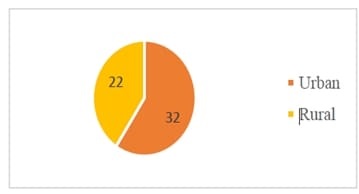Awareness and Perception of Sepsis Among the Urban and Rural Population in India

Abstract:
Traditionally,
immunity has been defined as a defence against, or as a resistance to,
contagious and infectious diseases. However, in modern understanding, it has
become apparent that the immune system's mechanisms that protect against
disease can also react against harmless substances. In some instances of severe
infection, it's important to be aware that the immune response generated may
have unintended adverse consequences. These conditions are associated with
sepsis and may even turn out to be life-threatening in certain cases. Sepsis is
a whole spectrum of diseases with a systemic and dysregulated host response to
an infection. Therefore, it is of utmost importance to investigate and
understand the level of awareness among the general public regarding this
condition. This study aimed to understand the level of awareness about sepsis
among the general population and to compare the perspectives of urban and rural
populations. This study revealed that the awareness among both populations is
low. Efforts should be made to increase awareness in India.
References:
[1] Singer, M., Deutschman, C. S., Seymour, C. W., Shankar-Hari,
M., Annane, D., Bauer, M., Bellomo, R., Bernard, G.R., Chiche, J.D.,
Coopersmith, C.M. and Hotchkiss, R. S., 2016, The third international consensus
definitions for sepsis and septic shock (Sepsis-3). Jama, 315(8),
pp.801-810.
[2] Komori, A., Abe, T., Kushimoto, S. et al. Characteristics
and outcomes of bacteremia among ICU-admitted patients with severe sepsis, Sci
Rep ,10, 2983 (2020).
[3] Gustot T., 2011, Multiple organ failure in sepsis: prognosis
and role of systemic inflammatory response. Curr Opin Crit Care, Apr.
17(2):153-9.
[4] Goh, A. Y. T., Chan, P. W. K., & Lum, L. C. S., 1999,
Sepsis, severe sepsis and septic shock in paediatric multiple organ dysfunction
syndrome. Journal of Paediatrics and Child Health, 35(5),
488-492.
[5] Vincent, J. L., & Gerlach, H., 2004, Fluid resuscitation
in severe sepsis and septic shock: an evidence-based review. Critical
Care Medicine, 32(11), S451-S454.
[6] Ziesmann, M. T., & Marshall, J. C., 2018, Multiple organ
dysfunction: the defining syndrome of sepsis. Surgical Infections, 19(2),
184-190.
[7] Dolmatova, E. V., Wang, K., Mandavilli, R., & Griendling,
K. K., 2021, The effects of sepsis on
endothelium and clinical implications. Cardiovascular Research, 117(1),
60-73.
[8] Rudiger, A., & Singer, M., 2007, Mechanisms of
sepsis-induced cardiac dysfunction. Critical Care Medicine, 35(6),
1599-1608.
[9] Biomarkers Definitions Working Group, Atkinson Jr, A. J.,
Colburn, W. A., DeGruttola, V. G., DeMets, D. L., Downing, G. J., Hoth, D. F.,
Oates, J. A., Peck, C. C., Schooley, R. T. and Spilker, B. A., 2001. Biomarkers
and surrogate endpoints: preferred definitions and conceptual framework. Clinical
Pharmacology & Therapeutics, 69(3), pp. 89-95.
[10] Cazalis, M.A., Friggeri, A., Cavé, L., Demaret, J., Barbalat,
V., Cerrato, E., Lepape, A., Pachot, A., Monneret, G. and Venet, F., 2013.
Decreased HLA-DR antigen-associated invariant chain (CD74) mRNA expression
predicts mortality after septic shock. Critical Care, 17(6),
pp.1-10.
[11] Quale, D.Z. and Droller, M.J., 2007, July. Cancer patient
advocacy: New opportunities for treatment advances. In Urologic
Oncology: Seminars and Original Investigations , Vol. 25, No. 4, pp.
351-352.
[12] Rubulotta, F. M., Ramsay, G., Parker, M. M., Dellinger, R. P.,
Levy, M. M., Poeze, M. and Surviving Sepsis Campaign Steering Committee, 2009.
An international survey: public awareness and perception of sepsis. Critical
Care Medicine, 37(1), pp.167-170.
[13]Mellhammar, L., Christensson, B. and Linder, A., 2015,
December. Public awareness of sepsis is low in Sweden. In Open Forum
Infectious Diseases , Vol. 2, No. 4, p. ofv161, Oxford University
Press.
[14] Al-Orainan, N., El-Shabasy, A. M., Al-Shanqiti, K. A.,
Al-Harbi, R. A., Alnashri, H.R., Rezqallah, R. A. and Mirghani, A. A., 2020.
Public Awareness of Sepsis Compared to Acute Myocardial Infarction and Stroke
in Jeddah, Saudi Arabia: Questionnaire Study. Interactive Journal of
Medical Research, 9(2), p.e16195.
[15] Park, M., Kim, K., Lee, J. H., Kang, C., Jo, Y. H., Kim, D. H.,
Kang, K. W., Lee, S. H., Park, C., Kim, J. and Chung, H., 2014. Awareness and
knowledge of sepsis in the general Korean population: comparison with the
awareness and knowledge of acute myocardial infarction and stroke. Clinical
and Experimental Emergency Medicine, 1(1), p.41.
[16] Kissoon, N., Reinhart, K., Daniels, R., Machado, M. F. R.,
Schachter, R. D. and Finfer, S., 2017. Sepsis in children: global implications
of the world health assembly resolution on sepsis. Pediatric Critical
Care Medicine, 18(12), pp.e625-e627.
[17] Cecconi, M., Evans, L., Levy, M., & Rhodes, A. (2018).
Sepsis and septic shock. The Lancet, 392(10141), 75-87.
[18] Bladon, S., 2023, Primary and secondary care patient health
record data linked to examine risk factors, mortality and antibiotic use in
sepsis , Doctoral dissertation, The University Of Manchester.
[19]
Rahman, N. I. A., Chan, C. M., Zakaria, M. I.,
& Jaafar, M. J., 2019, Knowledge and attitude towards identification of
systemic inflammatory response syndrome (SIRS) and sepsis among emergency
personnel in tertiary teaching hospital. Australasian Emergency Care, 22(1),
13-21.
[20] Salluh, J. I., Soares, M., & Singer, M., 2017, Spreading
the knowledge on the epidemiology of sepsis. The Lancet Infectious
Diseases, 17(11), 1104-1106
[21]
Vincent, J. L., 2008, European prevalence of
infection in intensive care. EPIC II study. 28th ISICEM.

